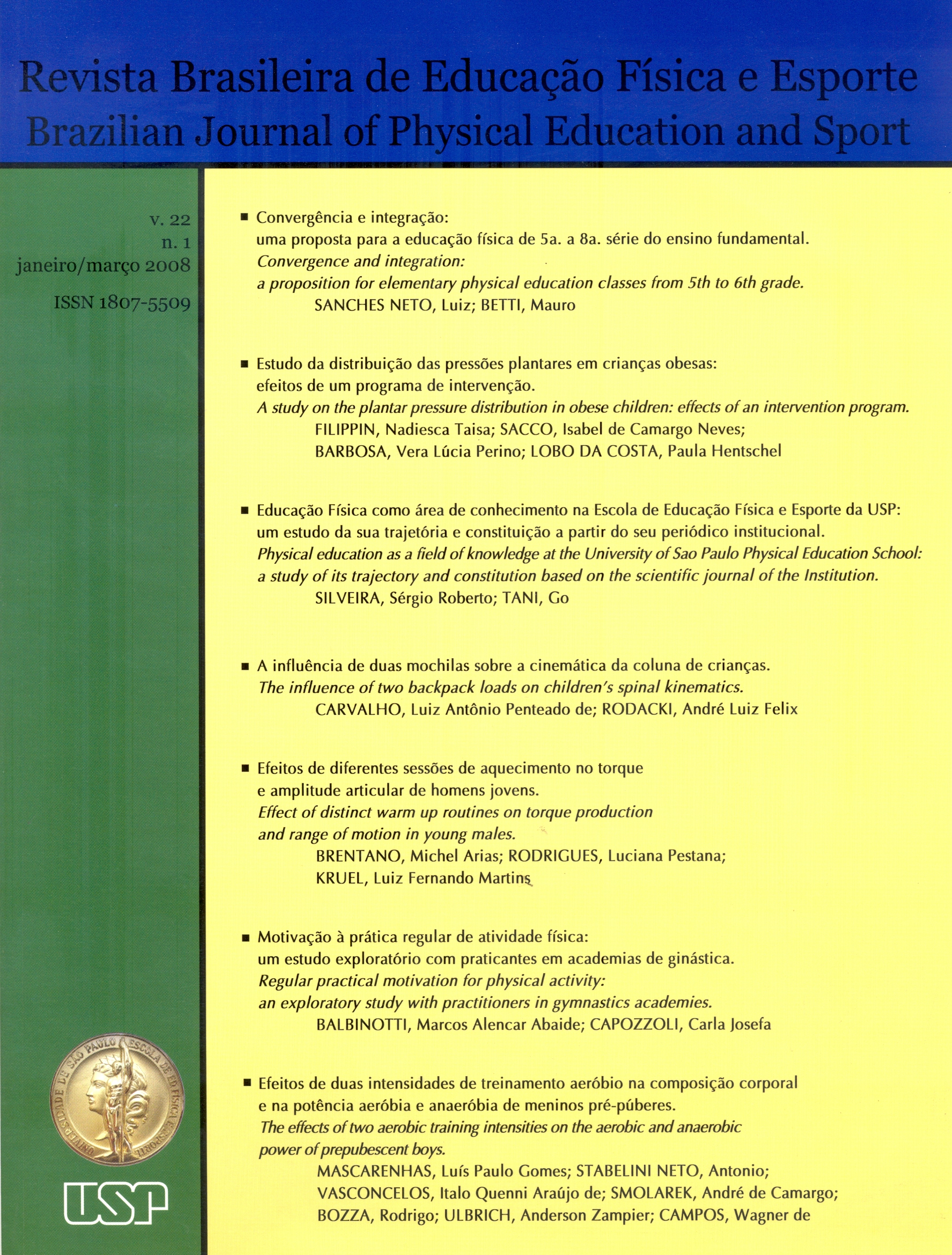A influência de duas mochilas sobre a cinemática da coluna de crianças
DOI:
https://doi.org/10.1590/S1807-55092008000100004Palabras clave:
Carregamento de cargas, Dor nas costas, MochilasResumen
Este estudo visou analisar o efeito do carregamento de cargas por meio de mochilas sobre a coluna. Os estudos que investigaram o carregamento de cargas utilizando mochilas têm analisado a dinâmica de membros inferiores e não tem focado a coluna vertebral. Em adição, as estratégias aplicadas por crianças podem diferir visto que as cargas relativas podem diferir entre adolescentes e adultos. Métodos: dez escolares (13,9 ± 0,6 anos; 1,53 ± 0,05 m; 44,9 ± 3,3 kg) foram voluntários para participar do estudo após seus pais consentirem e assinarem um formulário livre e esclarecido. Os participantes caminharam em uma esteira. Durante aproximadamente 15 minutos carregando uma mochila especialmente feita que correspondia a 0,10 e 20% do peso corporal. Um número de marcas corporais foi colocada nas costas dos sujeitos que permitiram a reconstrução dos perfis da coluna nos planos sagital e frontal. A relação entre os segmentos formados pelas marcas entre os acrômios e as cristas ilíacas foi usada como um índice de rotação da coluna. Os valores máximos, mínimos, médios e as amplitudes de movimento das regiões torácica e lombar e a coluna toda foram analisados. O ciclo da marcha foi normalizado pelo contato sucessivo de dois contatos do calcanhar com o solo. Resultados indicaram diferenças entre as cargas (10 e 20% PC). Um número de mudanças na cinemática da coluna foi encontrada. No plano sagital a amplitude de movimento permaneceu inalterada, todavia, houve um aumento na flexão a qual foi interpretada como uma estratégia compensatória em resposta ao efeito da carga. Os resultados estão em linha com a idéia que o uso de mochilas aumenta a inclinação anterior do tronco, mas em discordância com a noção que pronunciadas mudanças na amplitude de movimento ocorrem. O carregamento de cargas não produz um efeito claro sobre as variáveis selecionadas para identificar as alterações nas regiões lombar e torácica no plano sagital. Conclusão: o carregamento de cargas que correspondem a 20% PC influenciam a cinemática da coluna em todos os planos de movimento. Essas mudanças podem impor importantes mudanças sobre a postura e o estresse aplicado sobre os aspectos anteriores e posteriores da coluna vertebral. A baixa velocidade de deslocamento usada no presente estudo podem não ter induzido grandes mudanças na cinematica da coluna vertebral, como demonstrado em outros estudos que usaram maiores velocidades de deslocamento. Desta forma, sugere-se que o peso da mochila não é o único ator que determina os movimentos da coluna vertebral.Descargas
Los datos de descarga aún no están disponibles.
Descargas
Publicado
2008-03-01
Número
Sección
naodefinida
Licencia
Todo o conteúdo da revista, exceto onde está identificado, está licenciado sob uma Licença Creative Commons (CC-BY)
Cómo citar
Carvalho, L. A. P. de, & Rodacki, A. L. F. (2008). A influência de duas mochilas sobre a cinemática da coluna de crianças . Revista Brasileira De Educação Física E Esporte, 22(1), 45-52. https://doi.org/10.1590/S1807-55092008000100004


